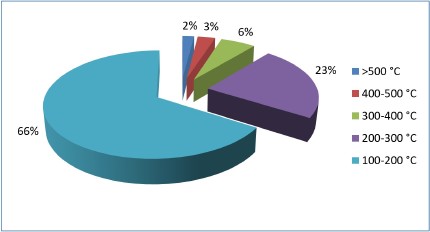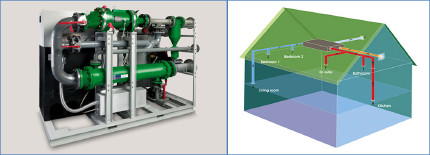Low-grade waste heat utilization in the European Union
28.6.2017
1. INTRODUCTION:
During many industrial processes heat is generated as a byproduct. Experts consider the dissipation of waste heat as a wasted opportunity if it is not recovered.
Some studies estimated that about 20-50% of the industrial energy consumption is discharged as heat. Waste heat recovery methods have shown a great development, however there is still a big potential in their improvement. Depending on the application, the heat can be the desired product or can be the input to another process to generate clean electricity. In case a certain quantity and quality of waste heat is available, it is recommended to invest to some kind of heat utilization facility. If we do so, we can spare money and lower the emission from our devices which are beneficial both for us and for our environment [1], [2].
In order to reach the EU’s goals regarding greenhouse gas emission, energy efficiency and the use of renewables, waste heat recovery can be an effective solution. The use of low-grade waste heat, as the most abundant source of all kind of waste heat, is a promising opportunity for industrial actors or even house owners, however, because of its low temperature it is quite problematic to reuse.
2. POLICY AND THE IMPORTANCE OF LOW-GRADE WASTE HEAT:
The European Commission proposed the Europe 2020 flagship initiative in order to provide policy plans in climate change, transport and energy. The overall goal is to make the EU a competitive low carbon economy by 2050. Within the framework of the Europe 2020 Strategy, member states committed themselves to reduce greenhouse gas emission by 20%, increase the use of renewables in the EU-s energy mix to 20%, and achieve the 20% energy efficiency goal by 2020. In February 2011 the EU Council reconfirmed the objective of reducing greenhouse gas emission by 80-95% by 2050 compared to 1990 level. This action was made in order to keep climate change below 2°C [3].
To achieve the European Union’s goals and because of the other beneficial reasons, it is recommended to the industrial actors to recover waste heat so as to generate electrical or mechanical power. Waste heat recovery is a direct way to achieve the first two key objectives (20% reduction of the GHG emission compared to the 1990’s level and 20% energy efficiency increase) of the EU policy. Most of the discharged waste heat during industrial processes is qualified as low-grade heat (under 200 °C) which is immensely difficult to utilize. The qualification of this resource is based on its temperature. High grade heat: temperature is higher than 650 °C, medium grade heat: temperature ranges between 200-277 °C and 650 °C, low grade heat: temperature is lower than 200-277 °C. According to a recent study, the most of the waste heat (66%) is low-grade. The chart below is showing the contribution to the overall waste heat quantity of each WH categories [4].

Figure 1-Waste heat temperature distribution in the industry [4]
On the chart above, we can see that how big the 100-200 °C waste heat’s contribution is to the overall heat source. As the temperature grows the size of slices reduces. This is the reason why it so essential to find the way to utilize the heat from colder intervals.
3. LOW-GRADE WASTE HEAT SOLUTIONS:
A large amount of low-grade waste heat (LGWH) between 30 °C and 250 °C are available in the process industries (chemical, petroleum, pulp and power, food and drink, manufacturing, iron and steel, and cement industries, etc) and a wide range of technologies are employed to recover this resource including heat pump, organic Rankine cycle, energy recovery from exhaust gas, absorption refrigeration or boiler feed water heating. The most widespread techniques in the industry are heat pumps and ORC systems. Heat pumps transfer the low-grade heat at low temperature to a higher temperature by a compressor. The main drawback about this technology is the fact that it uses quite a lot of external energy to convert low-grade heat to higher-grade heat. In the organic Rankine cycle systems organic fluids as working fluids are used for extracting electricity from LGWH. A typical ORC consists of a pump, a condenser, an evaporator and a turbine. The amount of energy used to make the pump work is considerably low making this method very effective. Besides these two solutions, low-grade waste heat is also used for boiler feed water heating when waste heat is utilized to increase the temperature of the income water to the boilers. If the heat is higher the boiler needs less energy to warm up the water to the ideal temperature, which may lead to lower consumption. In some industries WH is used for drying. The use of this resource in the industry is to dry the biomass that can result in the utilization of less fossil fuels. Drying can increase the calorific value and theoretical flame temperature of biomass making it more usable for industrial processes. There are also other already working technologies (absorption systems, thermo compressor, LGWH used for heating up spaces, rooms) to recover low-grade heat. Above, only the most widely utilized ones were described [5].
There are some examples demonstrating the feasibility and reliability of such solutions. A Slaughterhouse in Switzerland was improved by heat pumps. Low-temperature waste heat comes from a refrigeration system and the result is used for domestic heat water generation and heating. The annual saving is 260000 cubic meters of natural gas and 510 tons of CO2 [6]. In the UK an ORC system was installed by a foreign company. As input, it uses 77-122 °C income heat from biomass boiler. This is used in the ORC system to produce clean electricity, to dry the biomass and to heat up buildings [7]. Waste heat recovery might be a good way also for private house owners to spare money. Waste water heat recovery uses the heat of the water from bathrooms, kitchens to preheat fresh water [8]. Heat recovery ventilation makes profit from low-quality (moisty, smelly) warm air using a heat exchanger to warm up the incoming fresh air [9].

Figure 2-An ORC system [10] and the model of heat recovery ventilation [9]
4. CONCLUSIONS:
Europe has a leading role in developing low-carbon and energy efficiency solutions, and heat recovery can help the EU to reach the 20-20-20 objectives. Besides the obvious benefit of decarbonisation and sustainable growth, the use of waste heat recovery applications would contribute to job creation, the improvement of the Resource & Development sector and have a positive effect to productivity and competitiveness. Recovering this resource has proven to have the ability of being feasible, money-saving, and environmentally friendly and might be the next step for EU to reach her goals till 2020 and 2050 in the establishment of the base of a low-carbon economy and a more sustainable future [11].
References:
- BCS, Incorporated: Waste Heat Recovery: Technology and Opportunities in U.S. Industry, 2008
- Heat is Power: www.heatispower.org, 12.12.2016
- Communication from the Comission of the European Parliament, the Council, the European Economic and Social Commitee and the Commitee of the Regions: http://eur-lex.europa.eu/legal-content/EN/TXT/PDF/?uri=CELEX:52007DC0575&from=EN, 2017.01.29
- Some Efficient Solutions to Recover Low and Medium Waste Heat: Competitiveness of the Thermoacoustic Technology: http://www.sciencedirect.com/science/article/pii/S1876610214008613, 2017.01.29
- Advanced Process Integration for Low Grade Heat Recovery: http://research.ncl.ac.uk/pro-tem/components/pdfs/EPSRC_Thermal_Management_CPI_Interim_Report_16Feb.pdf, 2017.01.29
- http://www.durr-thermeco2.com/en/projects/item/625-slaughterhouse-zurich, 2017.01.29
- https://electratherm.com/orc-technology-generates-profitable-biomass-power-in-united-kingdom/, 2017.01.29
- http://powerpipehr.co.uk/housing/, 2017.01.29
- http://rega-uk.co.uk/heat-recovery-ventilation-hrv.html, 2017.01.29
- http://www.n2ies.com/waste-heat-recovery-organic-rankine-cycle.html, 2017.02.07
- EU paper: ORC Waste Heat Recovery in European Energy Intensive Industries: http://eur-lex.europa.eu/legal-content/EN/TXT/PDF/?uri=CELEX:52011DC0112&from=EN, 2017.01.29
